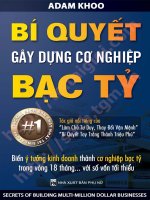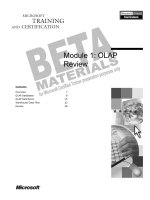Chapter 1, CH.1 microbiology review Flashcards _ Quizlet
Bạn đang xem bản rút gọn của tài liệu. Xem và tải ngay bản đầy đủ của tài liệu tại đây (1.06 MB, 8 trang )
10/10/2020
Prescott's Microbiology - Chapter 1, CH.1 microbiology review Flashcards | Quizlet
Scheduled maintenance: Saturday, October 10 from 4–5 PM PT
On Saturday, October 10th, we'll be doing some maintenance on Quizlet to keep things running smoothly. Quizlet will be unavailable
Dismiss
from 4-5 PM PT.
Prescott's Microbiology - Chapter 1, CH.1 microbio
review
Leave the first rating
STUDY
Learn
Flashcards
Write
Spell
Test
PLAY
Match
Key concepts:
Last Universal Common Ancestor
Bacteria And Archaea
Membrane Bound Organelles
Upgrade to remove ads
Only $2.99/month
Terms in this set (75)
Viruses
-acellular
-must invade a host to replicate
-packet of genetic information
- "parasite of a cell"
Norman Pace
-developed a universal phylogenetic tree
LUCA
-the Last Universal Common Ancestor
- at the origin of the phylogenetic tree
-shows that bacteria and archaea evolved
/>
1/8
10/10/2020
Prescott's Microbiology - Chapter 1, CH.1 microbiology review Flashcards | Quizlet
independent of each other because it is on the
bacterial branch
Carl Linnaeus
-made binomial system (/Genus species/)
pure / axenic culture
-culture removed from the natural habitats and
isolated from other microbes, problematic when
trying to observe behaviors
Edward Jenner
-experiment with cowpox in children, didn't get
smallpox (milkmaids were immune)
-created first vaccinations
microbiology
scientific study of microscopic organisms and viruse
list 6 groups of microorganisms
1. bacteria
2. archaea
3. protists
4. fungi
5. algae
6. viruses
which group of microorganisms
prokaryotes can survive in high salt, high temp, low
can exist in extreme
temp, and deep in the ocean
enviromental conditions
what group of the
viruses
microorganisms is neither a
prokaryote or eukaryote
2 examples of how
1. production of drinks and food 2. production of
microorganisms benefit man
antibiotics and insulin
which microogranism did hooke
fungi
first observe
Sponsored by Advertising Partner
Sponsored Video
S
Watch to learn more
Fleming
developed first penicillin greatest discovery to
microbiology
what year did Fleming develop
1929
penicillin
/>
2/8
10/10/2020
Prescott's Microbiology - Chapter 1, CH.1 microbiology review Flashcards | Quizlet
who said that if an organism is
Koch
exposed to a pathogen they will
get it
germ theory
The idea that disease was caused by living organism
what is a pure culture
culture containing 1 species
what is used to characterize
microscope
microbes of their physical
characteristics
3 types of microscopes
light
TEM transmission Electron microscopy
SEM scanning electron microscopy
what is a light microscope used
visualize living organisms move
for
why do we stain microbes
live bacteria cells lack color and contrast
what can you see with a TEM
visualization of internal cell structures
microscope
viruses
Upgrade to remove ads
Only $2.99/month
What can you see with SEM
the cells surface
scope
viruses
living organisms
how to classify and distinguish
staining
microbes
both eukaryote and prokaryotes
cell membranes barrier between the outside and th
have
inside
only bacteria have
true
microcompartments
prokaryotes have different
true
flagella but not cilia true or false
where does the energy
mitochondria and chloroplasts
/>
3/8
10/10/2020
Prescott's Microbiology - Chapter 1, CH.1 microbiology review Flashcards | Quizlet
metabolism take place in a
eukaryote
where does the energy
cytoplasm and cell membrane
metabolism take place in the
prokaryote
how are the cell shape and
light microscopy and staining
arrangement determined
prokaryotes lack what?
membrane bound organelles
what is the capsule made of
mix of polysacharides and proteins
what is the purpose of the
protection
capsule
structure and function of the
maintain cell shape and prevent distruction
rigid cell wall
gram positive cells attract and
true
hold more of the stain
color of the gram positive after
dark purple
stained
color of the gram negative after
pink
stained
building blocks and needed for
macroelements
energy reproduction
Cellular microbes include
1.Fungi(yeast/mold)
2. Protists (algae/protozoa/slime molds)
3.Bacteria (E.coli)
4.Archaea(methanogens)
Acellular microbes
1. Viruses (nucleic acids and proteins)
2. Viroids (RNA)
3. Virusoids (RNA)
4. Prions (Protein)
Microorganisms/Microbes
organisms that are too small to be seen with the eye
lack differentiated tissue
Prokaryotic cell structure
no nucleus
no membrane-bound organelles. single celled
/>
4/8
10/10/2020
Prescott's Microbiology - Chapter 1, CH.1 microbiology review Flashcards | Quizlet
Eukaryotic cells
larger
more complex
nucleus
membrane bound organelles
3 domains of life
Bacteria, Archaea, Eukarya
Domain bacteria
single celled
cell wall with peptidoglycan
no nucleus
ubiquitous
Cyanobacteria
Bacteria that can carry out photosynthesis
produce oxygen
Domain Archaea
unique rRNA sequences and membrane lipids
lack of peptidoglycan in cell wall
unusual metabolic characteristics
Domain Eukarya
protists, fungi, plants, animals
LUCA
-the Last Universal Common Ancestor, which is
placed at the origin of the phylogenetic tree, shows
that bacteria and archaea evolved independent of
each other because it is on the bacterial branch
strain
-consists of descendants of a single, pure microbial
culture
Bacteria and Archaea
don't reproduce sexually and are considered strains
tools used to study
microscopes
microorganisms
culture techniques
molecular genetics
genomics
Francesco Stelluti
observed bees and weevils between 1625-1630
Robert Hooke (1665)
Discovered cells
published drawings of the fungus Mucor in his book
Anthony van Leeuwenhoek
first person to observe and describe microorganism
accurately using microscope (1632-1723)
spontaneous generation
Hypothesis stating that life could arise from nonlivin
matter.
/>
5/8
10/10/2020
Prescott's Microbiology - Chapter 1, CH.1 microbiology review Flashcards | Quizlet
Francesco Redi
disproved spontaneous generation
showed that maggots don't arise from decaying me
John Needham(1713-1781)
-he put broth in flasks -> boiled -> sealed it
-later, the broth contained microorganisms
-showed that microorganisms don't grow from eggs
Lazaro Spallanzani
1729-1799
•put water and seeds in flasks ,sealed it then boiled
•Results: no growth of microorganisms.
Louis Pasteur (1822-1895)
Swan-neck flask' experiments
-placed nutrient solution in swan-neck flasks
-boiled the solutions
-left flasks exposed to air
Results: no growth of microorganisms
John Tyndall experiment
-demonstrated that dust carries microorganisms
- provided evidence for the existence of heatresistant forms of bacteria
Ferdinand Cohn (1828-1898)
heat resistant bacteria could produce endospores
Agostino Bassi
showed that a disease of silkworms was caused by a
fungus
M.J. Berkeley
demonstrated that the great Potato Blight of Ireland
was caused by a water mold
Heinrich de Bary
showed that smut and rust fungi caused cereal crop
diseases
Louis Pasteur on
demonstrated that microorganisms carried out
microorganisms and disease
fermentations
(1822-1895)
Pasteruization
used in processing milk products, fruit juices,
beer,wine.
kill pathogens to reduce food spoilage
Jospeh Lister
created antiseptic surgery system
/>
6/8
10/10/2020
Prescott's Microbiology - Chapter 1, CH.1 microbiology review Flashcards | Quizlet
discovered how antiseptics prevent infection
Robert Koch (1843-1910)
-demonstrated the germ theory
-Identified cause of anthrax, TB, and cholera
-Developed pure culture methods
Koch's Postulates
rules for proving that a microorganism causes a
specific disease.
Koch's work led to discovery or
-agar
development of:
-Petri dishes
-nutrient broth and nutrient agar
-methods for isolating microorganisms
Charles Chamberland (1851-
-developed porcelain bacterial filters to study
1908)
tobacco mosaic disease
determined that extracts from diseased plants had
infectious agents present
infectious agents were eventually shown to be virus
Emil von Behring (1854-1917)
developed antitoxins for diphtheria
and Shibasaburo Kitasato (18521931)
Elie Metchnikoff (1845-1916)
-first person to discover phagocytosis
- bacteria-engulfing, phagocytic cells in blood
-evidence for cellular immunity
Sergei Winogradsky and
Studied soil microorganisms and discovered
Martinus Beijerinck
metabolic processes (e.g., nitrogen fixation)
Pioneered use of enrichment cultures & selective
media
THIS SET IS OFTEN IN FOLDERS WITH...
F-2 Lecture (Prescott's Microbiology
chapter…
Prescott's Microbiology
Chapters 4
33 terms
30 terms
sngoebel TEACHER
Prescott's Microbiology Chapter 1
soi74
Microbiology MCB 3020 FAU CH
43 terms
216 terms
sevytay
austinbilaal
/>
7/8
10/10/2020
Prescott's Microbiology - Chapter 1, CH.1 microbiology review Flashcards | Quizlet
1/3
/>
8/8









